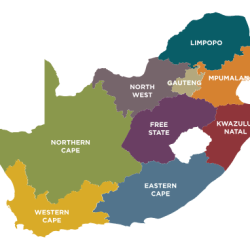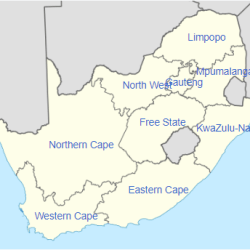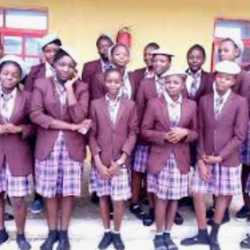How some major areas in South Africa got their names. Some of the areas are provinces.
Gauteng
Gauteng is a Sotho word for ‘place of gold’.
South Africa was blessed with gold. The country served as a major provider of gold for many years.
Mpumalanga
Mpumalanga means ‘where the sun rises’
Natal
The word Natal is Portuguese for Christmas, named by Captain Manuel Mascaranhas when he established it on Christmas day of 1597 (25 December 1597)
Orange Free State
Orange Free State is named after the Orange River, which was named for the ruling Dutch family of Orange-Nassau
Transvaal
Transvaal stands for Latin trans: beyond + Vaal River (from Afrikaans vaal: yellowish), land beyond the Vaal from viewpoint of Capetown
Provinces of South Africa
South Africa comprises 9 provinces. There are:
Eastern Cape
Free State
Gauteng
KwaZulu-Natal
Limpopo
Mpumalanga
Northern Cape
North-West
Western Cape

Administration
South Africa’s provinces are governed, in different ways, on a national, provincial and local level.
Nationally, there is the National Council of Provinces, one of the houses of Parliament.
Then there is the provincial government and, below that, the administration of district and metropolitan municipalities.
National Council of Provinces
South Africa has two houses of parliament: the National Assembly, and the National Council of Provinces.
The second exists to ensure that the interests of each province are protected in the laws passed by the National Assembly.
Each one of South Africa’s nine provinces sends 10 representatives to the National Council of Provinces. Six of these are permanent members of the council, and four are special delegates.
Provincial government
Each province is governed by a unicameral legislature.
The size of the legislature is proportional to population, ranging from 30 members in the Northern Cape to 80 in KwaZulu-Natal.
The legislatures are elected every five years by a system of party-list proportional representation; by convention, they are all elected on the same day, at the same time as the National Assembly election.
The provincial legislature elects, from amongst its members, a Premier, who is the head of the executive. The Premier chooses an Executive Council consisting of between five and ten members of the legislature, which is the cabinet of the provincial government. The Members of the Executive Council (MECs) are the provincial equivalent of ministers.
The powers of the provincial government are limited to specific topics listed in the national constitution. On some of these topics – for example, agriculture, education, health and public housing – the province’s powers are shared with the national government, which can establish uniform standards and frameworks for the provincial governments to follow; on other topics the provincial government has exclusive power.
The provinces do not have their own court systems, as the administration of justice is the responsibility of the national government.



